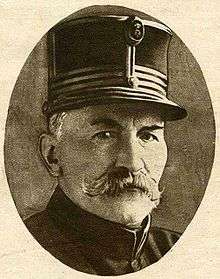Gérard Leman
| Gerard Mathieu Joseph Georges Leman | |
|---|---|
 | |
| Born |
8 January 1851 Liège, Belgium |
| Died |
17 October 1920 (aged 69) Liège, Belgium |
| Nationality |
|
| Known for | Organising the defence of Liège during World War I |
Gerard Mathieu Joseph Georges, count Leman (8 January 1851 Liège – 17 October 1920 Liège) was a Belgian general. He was responsible for the military education of King Albert I of Belgium. During World War I he was the commander of the forts surrounding the Belgian city of Liège. The German Forces had to use heavy artillery to break through the defences and capture Leman as a prisoner of War. He was released at the end of the war and died a hero, in 1920.
Pre-World War I
Leman was the son of an artillery captain who was a professor at the Military School. He entered the Military School at Brussels, and when he left it in 1869 had acquired a reputation for brilliance. During the Franco-German War, he served in a Belgian observation corps. In 1882, he became a member of the teaching staff of the Military School, and both then and later, as head of the school, he exerted considerable influence on military matters, becoming famous as a mathematician.[1] During this period he was responsible for the military education of King Albert I of Belgium and the Filipino general Antonio Luna.
Preparing Liège
In January 1914, he was appointed commander of the forts surrounding the Belgian city of Liège as well as the 3rd division of the Belgian army.[1] Leman was determined to hinder the German advance as much as possible. Over 18,000 labourers were set to work building fortifications around Liège. During a visit by a Belgian minister, Leman was told that these projects would compromise the neutrality of Belgium. Leman was unimpressed and replied that Belgium would come to thank him if war would break out; if no war came "they could take away his general’s stars".
Battle of Liege
In August 1914, German forces under the command of General Otto von Emmich appeared before Liége and summoned it to surrender. On Gen. Leman's refusal, the fortress was attacked, and the Battle of Liège began.[1] Gen. von Emmich's forces were initially unable to break through his fortifications: only after they used very heavy artillery (Big Bertha and other heavy guns, brought from Germany and Skoda works), against the forts did they succeed in knocking them out. Leman was knocked unconscious by the bombardment, and was rescued by the Germans from under the debris of Fort Loncin. He was held as a prisoner of war in Germany until 1917, when he was repatriated to Switzerland due to ill health.[2] As a token of respect, he was allowed to retain his sword.[1] Leman insisted that the report of his capture mentioned that he did not surrender, but was captured unconscious.[3]
After the war
After the war, he returned to a hero’s welcome in Belgium. He died in 1920, aged 69.
Honours
-
.svg.png) Belgium: Grand cordon in the Order of Leopold with palm, 1918.
Belgium: Grand cordon in the Order of Leopold with palm, 1918. -
.svg.png) Belgium: Grand officer Order of the Crown
Belgium: Grand officer Order of the Crown -
.svg.png) Belgium: War cross 14-18
Belgium: War cross 14-18 -
 United Kingdom: Knight Grand Cross in the Order of Saint Michael and Saint George.
United Kingdom: Knight Grand Cross in the Order of Saint Michael and Saint George. -
 France: Knight Grand Cross of the Legion of Honour.
France: Knight Grand Cross of the Legion of Honour. -
 France: War Cross
France: War Cross - Grand Cross in the Order of the Star, Romania
- Grand Cross in the Imperial Order of the Double Dragon, China
By royal decree made nobility with rank of count.
References
- 1 2 3 4
 Chisholm, Hugh, ed. (1922). "Leman, Gérard Joseph Mathieu Georges". Encyclopædia Britannica (12th ed.). London & New York.
Chisholm, Hugh, ed. (1922). "Leman, Gérard Joseph Mathieu Georges". Encyclopædia Britannica (12th ed.). London & New York. - ↑ Baker, Chris: Brave Little Belgium, http://www.firstworldwar.com/features/liege.htm
- ↑ Meyer, G.J.: A World Undone: The Story of the Great War 1914 to 1918, page 135. Delacorte Press, 2007.